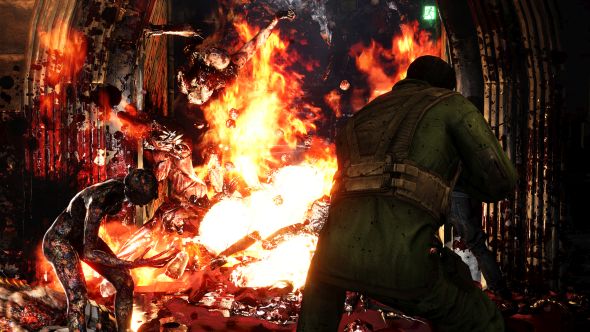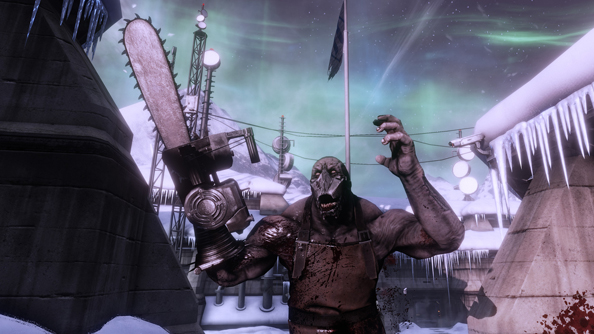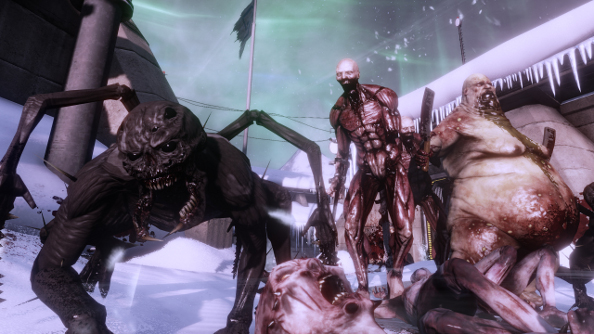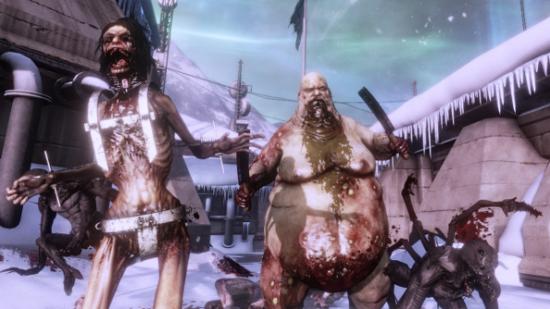Amidst the chaos of Killing Floor 2’s relentless zombie hordes, guts, gore, and strewn limbs, there’s an occasional moment of zen. A slow-motion effect called Zed Time phases in out of nowhere, the colour washes out, and you get some respite from the madness. It allows you the time to line up a series of pinpoint headshots, or reload your guns as you back away from a stampeding behemoth, while at the same time appreciating the over-the-top physics and buckets of grisly viscera soaring through the sky.
If you like making dead things deader, check our list of the best zombie games.
When the first Killing Floor was late into development, Tripwire Interactive’s president, John Gibson, was lying in bed, staring at his ceiling fan. “The first thought that popped into my head was ‘slow-motion zombie killing’,” Gibson says. “It was like a bolt out of the blue, really, and I couldn’t get the idea out of my head. I thought about it all morning. I really felt like it would be something amazing to experience as a player.”
Gibson could see it clearly in his head: The Matrix’s corridor scene and Max Payne’s slow-mo shootouts, in a game about tearing through hordes of zombies. It was the perfect fit. The only problem was that Killing Floor was due to launch in just two weeks. “At that point, developers really shouldn’t be adding new features to their games,” Gibson laughs. “That is the point in a project where devs are fixing final bugs, doing some balance tweaks, etc. We were so close to shipping that I didn’t even want to tell the other team members about the idea, because trying it would be so risky that late in development.”

So Gibson went to work on the feature on his own. He set a self-imposed deadline of one hour, and promised himself he would scrap the idea and never mention it to the team at all if he couldn’t meet it. In less than 60 minutes his slow-motion mechanic was up and running. It wasn’t long before he had the prototype working in multiplayer, watching his colleagues dodge projectiles, pop heads, and see their spent cartridges ejecting from their weapons in glorious slow-motion. Presented with it in action, the team decided to get to work on refining the idea for the impending release.
“It really started with the idea to show off the awesome gunplay as well as the gore and ragdoll deaths in slow-motion,” Gibson explains. “At Tripwire, we’ve always felt that for weapons to feel powerful they need to impact on the enemy, and the ragdoll force when they are shot must feel very weighty and powerful. So the thought of seeing that in slow-motion was very exciting, and as it turned out it did look amazing. Once we played with it, though, we saw that it was such a great tool to give players a moment to catch their breath and regain their footing in the midst of all the carnage. We then built on it from there to add chaining of Zed Time to extend the length of the slow-motion, as well as building it into other parts of the game.”
But first, Tripwire had to fix up parts of the game engine that didn’t play nice with Zed Time, as well as figure out how to sync up the game’s audio for when the action slows, all in time for launch. You see, Zed Time slows the game to 20% speed, and the audio sounded awful when pitched down to match. The sweet spot for audio was 50%, but that made some of the weapons, particularly automatics, sound out of sync. With a little effort, they managed to fix this, and then introduced the distorted, time-warping sound effect, created by Dan “zYnthetic” Nassick, that triggers upon entering Zed Time. It was ready for launch. Given that the mechanic had been cobbled together in a matter of weeks, however, there was room for improvement. Which is where the sequel comes in.

“In Killing Floor 2 it was much more challenging because we set out to resolve players’ biggest complaint from the first game – getting Zed Time when nothing was going on around them,” Gibson says. “No one likes slow-motion dramatic welding or slow-motion dramatic walking with no enemies around to shoot. So for Killing Floor 2 we implemented a system that would allow players that didn’t have any zed enemies around to continue at a normal time rate. It was extremely complex and challenging to implement, so much so we almost gave up several times. Slowing down the whole game in multiplayer wasn’t too hard. Slowing parts of the game down in multiplayer while other players continue at normal speed was really challenging. We had problems with the physics system, networking, effects, etc. But we persisted and the end result made Zed Time in Killing Floor 2 so much more enjoyable.”
Zed Time is triggered by a random chance on every enemy kill, so their distribution is sporadic. It leads to some incredible moments when you, for example, find yourself scanning a torso as it slowly flies off the map in the midst of a smoky rocket explosion. Or when the effect triggers on an ally’s kill and you’re mid-jump, allowing you to twist and pull of a seemingly impossible headshot. It’s incredibly slick, and I can’t imagine Killing Floor 2 being anywhere near as enjoyable without it. Obviously, it helps that it also creates those gory moments of visual spectacle, allowing you to savour the aftermath of your melee decapitations.

“The chance increases as the player does things that the system thinks will look cool for them to see in slow motion – blasting a zed with a shotgun up close, getting a headshot, killing multiple zeds at the same time,” Gibson explains. “The system also looks at how long it has been since Zed Time was triggered. The longer it has been, the higher the chance that Zed Time will occur, until it is basically guaranteed to happen. This system has worked out pretty well, with having Zed Time spread out to an interval that feels good for the player but also not rigidly happening at exact intervals.”
While some shooters get their kicks from damage numbers, colour-coded loot, and other methods of visual feedback, Killing Floor 2 keeps you coming back with its surprise slow-mo gibs. While structurally similar, I think that’s what elevates Killing Floor 2 above Call of Duty’s various zombie modes. It’s the excess, the carnage, and how the pacing is impacted by Zed Time. Who doesn’t like suddenly being rained on by falling entrails? Eh? EH? It is genius. Honestly, I’m considering investing in a ceiling fan.
